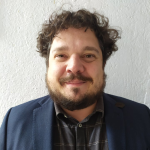Charles-Étienne BENOIT
With a beginning in biological and animal science between McGill University in Montreal and the University of Sherbrooke in Canada, Charles-Étienne redirected his career to clinical research by accepting in 2010 a Marie-Curie scholarship within the EBRAMUS consortium specializing in research exploring the effect of music on the brain, in particular involving himself in a project using rhythm in the motor rehabilitation of walking disorders. A European journey between three institutions, the University of Economics and Human Sciences in Warsaw (Poland), the Max-Planck Institute for Human Cognitive and Brain Sciences in Leipzig (Germany) and the Integrated Platform for the Studies of Human Movement Euromov in Montpellier (France) which culminated in obtaining his doctorate diploma in 2015 at the University of Leipzig in Germany. He then accepted a two-year contract (2016 - 2018) at the Catholic University of Louvain within the Institute of Neurosciences (IONS) in Brussels (Belgium). He worked on projects studying mental fatigue behaviorally and using brain imagery. Then for the next three years, he worked as an associate-professor returning to the University of Economics and Human Sciences in Warsaw (Poland) as the director of the psychology laboratory (2018 - 2021). He has been recruited since 2021 at the University Claude Bernard Lyon 1 as an associate-professor in the Inter-University Laboratory of Motricity Biology (LIBM). |
Charles-Étienne BENOIT (charles-etienne.benoit @ univ-lyon1.fr) Institution : Université Claude Bernard Lyon 1 Team : [MP3] Position : Maître de conférences Publications : |
|
His research activities focus on the study of rhythm and music on the motor and cognitive abilities of healthy and pathological individuals. He is interested in motor learning, cognitive fatigue, sleep, the impact of breathing and endogenous rhythms on memory, the impact of technology on mental or physical health. All with a strong interest in cognitive behavioral sciences, neuroplasticity, pharmacology and applied neuroscience. | |
| |



